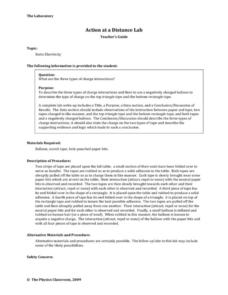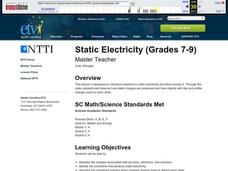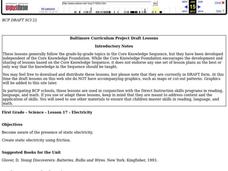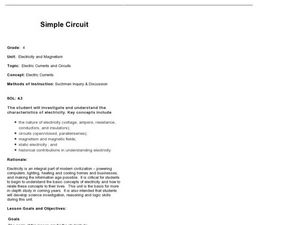Science Matters
Static Electricity
Working with static electricity is sure to give the class a charge! Budding scientists experiment with balloons and different materials to discover how to create static electricity. They learn about the transfer of electrons and the...
Curated OER
Static electricity: Ah, There's the rub!
Students experiment to investigate static electricity. In this static electricity instructional activity, students prepare a balloon head and draw a face on it. Students rub the nose and the balloon moves toward the student...
Curated OER
Exploring Electricity - Four Activities
These are four classic activities used for instructing upper elementary electricians. The first involves experimenting with the Van de Graaff generator. The second is a series of hands-on experiences with static. In the third activity,...
Curated OER
Green Team
Student explore the relationship of static electricity to current electricity, circuits, electromagnets, electro generators, and public electric utilities. In this Green Team lesson plan, 4th graders participate in hands-on science...
Physics Classroom
Action at a Distance Lab
The concepts involved with static electricity are typically taught in upper elementary physical science units. The lab described in this resource has pupils examine the behavior of small pieces of paper and a balloon when a charged piece...
Curated OER
Static Electricity
Young scholars are introduced to the concept of static electricity and its causes. After viewing video segments, they observe its effect on various objects. In groups, they discover how static electricity is produced and how objects...
Curated OER
Static Electricity
Students engage in a lesson that is concerned with the concept of static electricity. They conduct an experiment with balloons and make observations of how it works. The data is collected and written down and they define positive,...
Curated OER
Electricity
First graders become aware of the presence of static electricity. They create static electricity using friction.
Curated OER
Introduction to Magnets
Students explore magnetism, electromagnetism, and static electricity through a series of activities and experiments. In this magnets lesson, students use magnets to observe the forces of attraction and repulsion between different poles....
Curated OER
Sliders - Static and Kinetic Friction
Students work in groups to conduct experiments the demonstrate the differences between static and kinetic friction. They consider how friction affects us in our everyday lives, determine the effects of weight on friction and complete a...
Curated OER
Simple Circuit: Electric Currents and Circuits
Through inquiry and exploration, 4th graders will learn and understand the functions of open and closed circuits. They will break into 2 groups, define vocabulary, hypothesize how to light a bulb, then test their hypothesis 4 different...
Curated OER
MINI-UNIT on ELECTRICITY
Students identify hypotheses related to static electricity, to begin to test the hypotheses, to begin to develop conclusions related to observations, to demonstrate that like charges repel and unlike charges attract each other, to name...
Curated OER
Take Charge!
Students induce an electrical charge on various objects, and experiment with electrical repulsion and attraction. They define related vocabulary, play Bingo and complete a take-home quiz.
Curated OER
Electrical Safety
Students create a list of things that they do with electrical power. They then are shown a PowerPoint on "Basic Electrical Safety." Students evaluate electrical equipment, cords and situations for serviceability and safety problems. They...
Curated OER
Electricity Crossword
In this electricity worksheet, students complete a crossword puzzle by figuring out the vocabulary words associated with the 20 clues given.
Curated OER
Static Cling
Students work together to discover the concept of static electricity. They participate in an experiment in which they test different objects charge. They make observations and record them for later use.
Curated OER
Focusing Event to Electricity
Students explain how electrical charges behave. For this electricity lesson, students determine how far away lightning is when it strikes. They research how fabric softener reduces static electricity and share their findings in class.
Curated OER
School House Rock! Science Rock
Learners use common household and classroom objects to generate static electricity and study its effects. They discuss the video Science Rock CD called Electricity, Electricity. The video explains many things about electricity.
Curated OER
Electrical Resistivity
Students examine how materials oppose the flow of an electrical current. In this resistivity lesson students complete several experiments on the differences between resistance and resistivity.
Curated OER
Its Electric!
Fourth graders define the differences between static and current electricity by participating in an investigation. In this energy lesson, 4th graders utilize electrical supplies to demonstrate the differences between static and...
Curated OER
Electricity for Kids! It's Shocking!
Learners investigate the world of electricity by completing a KWL sheet. In this energy lesson, students view PowerPoint presentations about electricity, who invented it, and how it is used today. Learners define several electricity...
Curated OER
TE Activity: Does Weight Matter?
Students design and conduct experiment to determine if weight added incrementally to an object affects amount of friction encountered when it slides across a flat surface. They graph data from their experiments, and calculate...
Curated OER
Introduction to Friction
Young scholars study the properties of the frictional force between two surfaces in contact. They inspect various phenomena in nature where friction plays an important role and demonstrate
Curated OER
TE Lesson: Factors Affecting Friction
Learners investigate the effect of weight on normal friction or the friction due to surface roughness. They tell about the effects of contact area that occurs as a result of molecular attraction by looking at data on line graphs.

























